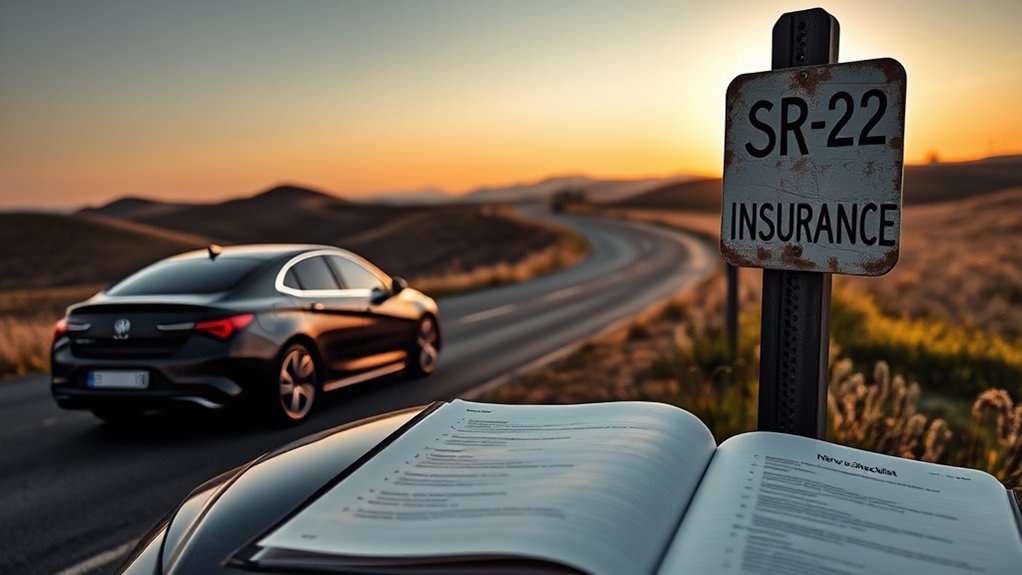Did you know that nearly 25% of new drivers end up classified as high-risk by insurance companies? This can lead to higher premiums and limited coverage options. However, there are strategies you can employ to find the best insurance for your situation. By understanding your options and taking proactive steps, you can navigate the high-risk insurance landscape more effectively. Let's explore some essential tips to help you secure the coverage you need.
Key Takeaways
- Compare quotes from multiple insurers to find the best rates for high-risk drivers and identify coverage options that meet your needs.
- Look for discounts for low mileage, completion of defensive driving courses, or safety devices to help lower your premium costs.
- Maintain continuous coverage to establish a positive insurance history and avoid being labeled as high-risk, which can lead to higher premiums.
- Consider non-standard insurance options designed for high-risk drivers, which may provide more tailored coverage despite higher costs.
- Seek advice from independent agents who can help navigate your unique situation and find suitable high-risk insurance options.
Understanding SR-22 Insurance in Ohio

If you find yourself needing SR-22 insurance in Ohio, it's important to understand that this isn't an insurance policy but rather a form that proves you have the minimum required liability coverage.
You'll need to maintain at least $25,000 for bodily injury per person, $50,000 total for bodily injury, and $25,000 for property damage. This filing must remain active for a minimum of three years, depending on your specific offense. SR-22 insurance is required for individuals with a license suspension due to OVI convictions or driving without insurance. Additionally, having SR-22 insurance can be a crucial step in regaining your driving privileges.
Failing to keep your SR-22 can result in license suspension and potential fines. Filing fees are usually low, ranging from $20 to $50.
You can file an SR-22 with both owner's and non-owner's auto insurance policies, ensuring you meet Ohio's liability requirements.
Identifying Your High-Risk Status
Understanding your high-risk status is essential for new drivers, especially those who may need SR-22 insurance. Factors that contribute to your classification include DUI or OWI convictions, multiple at-fault accidents, and driving without insurance.
Recognizing your high-risk status is crucial for new drivers, particularly when SR-22 insurance may be necessary.
If you're a new or inexperienced driver, or have excessive traffic violations, your risk assessment might be higher. Additionally, at-fault collisions and numerous speeding tickets can impact your driving record.
Serious offenses like reckless driving can lead to significant consequences, including higher premiums or policy cancellations.
Finally, owning a high-performance vehicle can also classify you as high-risk. It's important to recognize these indicators, as they influence your insurance options and financial responsibilities.
Shopping Around for the Best Rates
How can you find the best rates for high-risk insurance? Start by comparing coverage options from various insurers to ascertain they meet your needs.
Look for discounts specifically for high-risk drivers, and check the financial stability and customer service ratings of each provider.
Utilize online platforms and insurance comparison websites to gather quotes quickly. Don't hesitate to contact independent agents for tailored advice.
Explore discounts for low mileage, safety devices, and defensive driving course completion.
Consider how your credit score and geographic location affect rates, and think about increasing your deductible to lower premiums.
Finally, seeking assistance from insurance brokers can help you navigate the complexities of high-risk insurance effectively.
Exploring Non-Standard Insurance Options

For new drivers facing challenges in securing standard insurance, exploring non-standard insurance options can be a practical solution.
Non-standard insurance caters to higher-risk drivers, such as those with accidents or limited experience. While premiums may be higher and coverage options more limited, specialized providers often offer flexible policies tailored to your needs.
Eligibility typically involves a review of your driving record and other risk factors like age and credit history. If you've been denied standard coverage or have a lapse in insurance, non-standard policies might be your best route.
Be sure to compare quotes from multiple insurers, as this is essential for finding the most affordable option that meets your requirements.
Taking Advantage of Available Discounts
Finding affordable insurance is often a challenge for new high-risk drivers, but taking advantage of available discounts can greatly lower your premiums.
Look for low-mileage and safety device discounts, which many insurers offer. If you maintain a high GPA, don't forget about good student discounts. Taking a defensive driving course could also earn you a rate reduction in certain states.
Additionally, bundling your auto insurance with home insurance can lead to substantial savings. Remember, improving your credit score can positively impact your insurance rates too.
Finally, use online platforms like Cheapquotesautoinsurance.com to compare quotes from multiple insurers, ensuring you select the most cost-effective policy tailored to your needs.
Maintaining Continuous Coverage
Maintaining continuous coverage is vital for new drivers since it helps establish a positive insurance history and avoid being labeled as high-risk. Gaps in your insurance can lead to higher premiums and limit your options, making it essential to keep your policy active.
Insurance companies reward those with uninterrupted coverage by offering lower premiums over time, which can be beneficial as you gain driving experience. Even if you change vehicles or residences, guarantee your insurance remains active.
Consider shopping around for affordable options and regularly review your policy to avoid lapses. By prioritizing continuous coverage, you not only protect yourself financially against unforeseen incidents but also pave the way for better insurance opportunities in the future.
Building a Clean Driving Record Over Time

As you commence your journey as a new driver, building a clean driving record is essential for securing favorable insurance rates and establishing your credibility on the road.
Start by strictly following traffic laws to avoid fines and points. Stay focused and avoid distractions like texting or eating. Practice defensive driving techniques to anticipate hazards and keep your vehicle well-maintained to prevent accidents.
Always avoid alcohol or drugs while driving, as high-risk status can arise from DUIs or accidents. Consider taking defensive driving courses, which may also lower your insurance rates.
Regularly check your driving record for accuracy, and contest any incorrect information. Over time, maintaining a clean record will help shift you from high-risk to standard insurance status.
Conclusion
In your journey to secure high-risk insurance, remember to compare quotes, explore non-standard options, and seek discounts. Maintain continuous coverage to strengthen your insurance history, and review your driving record for accuracy. By building a clean driving record over time, you not only enhance your chances for better rates but also gain peace of mind. Stay proactive, stay informed, and stay committed to safe driving to guarantee you get the best coverage for your needs.

